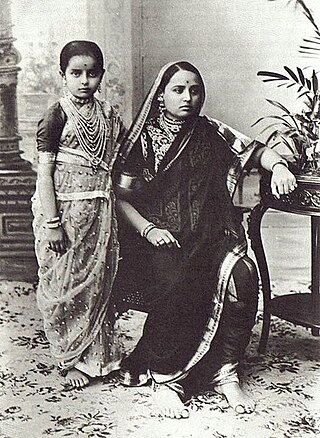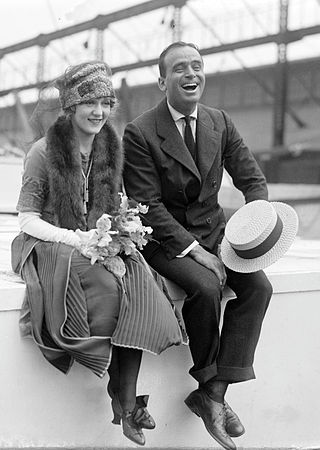Related Research Articles

There are typically two types of clothing worn in Japan: traditional clothing known as Japanese clothing, including the national dress of Japan, the kimono, and Western clothing, which encompasses all else not recognised as either national dress or the dress of another country.

A sari is a women's garment from the Indian subcontinent, that consists of an un-stitched stretch of woven fabric arranged over the body as a robe, with one end attached to the waist, while the other end rests over one shoulder as a stole (shawl), sometimes baring a part of the midriff. It may vary from 4.1 to 8.2 metres in length, and 60 to 120 centimetres in breadth, and is form of ethnic wear in India, Sri Lanka, Nepal, Bangladesh and Pakistan. There are various names and styles of sari manufacture and draping, the most common being the Nivi style. The sari is worn with a fitted bodice also called a choli and a petticoat called ghagra, parkar, or ul-pavadai. It remains fashionable in the Indian Subcontinent today.

A folk costume expresses a national identity through clothing or costume, which is usually associated with a specific region or period of time in history. It can also indicate social, marital, or religious status. If the costume is used to represent the culture or identity of a specific ethnic group, it is usually known as ethnic costume. Such costumes often come in two forms: one for everyday occasions, the other for traditional festivals and formal wear. The word "costume" in this context is sometimes considered pejorative due to the multiple senses of the word, and in such cases "clothing", "garments" or "regalia" can be substituted without offense.
Clothing in India varies with the different ethnicities, geography, climate, and cultural traditions of the people of each region of India. Historically, clothing has evolved from simple garments like kaupina, langota, achkan, lungi, sari, to rituals and dance performances. In urban areas, western clothing is common and uniformly worn by people of all social levels. India also has a great diversity in terms of weaves, fibers, colors, and the material of clothing. Sometimes, color codes are followed in clothing based on the religion and ritual concerned. The clothing in India also encompasses a wide variety of Indian embroidery, prints, handwork, embellishments, and styles of wearing clothes. A wide mix of Indian traditional clothing and western styles can be seen in India.

A petticoat or underskirt is an article of clothing, a type of undergarment worn under a skirt or a dress. Its precise meaning varies over centuries and between countries.

The malong is a traditional Filipino-Bangsamoro rectangular or tube-like wraparound skirt bearing a variety of geometric or okir designs. The malong is traditionally used as a garment by both men and women of the numerous ethnic groups in the mainland Mindanao and parts of the Sulu Archipelago. They are wrapped around at waist or chest-height and secured by tucked ends, with belts of braided material or other pieces of cloth, or are knotted over one shoulder. They were traditionally hand-woven, with the patterns usually distinctive to a particular ethnic group. However, modern malong are usually machine-made or even imported, with patterns that mimic the traditional local designs.

Western fashion in the 1920s underwent a modernization. For women, fashion had continued to change away from the extravagant and restrictive styles of the Victorian and Edwardian periods, and towards looser clothing which revealed more of the arms and legs, that had begun at least a decade prior with the rising of hemlines to the ankle and the movement from the S-bend corset to the columnar silhouette of the 1910s. Men also began to wear less formal daily attire and athletic clothing or 'Sportswear' became a part of mainstream fashion for the first time. The 1920s are characterized by two distinct periods of fashion: in the early part of the decade, change was slower, and there was more reluctance to wear the new, revealing popular styles. From 1925, the public more passionately embraced the styles now typically associated with the Roaring Twenties. These styles continued to characterize fashion until the worldwide depression worsened in 1931.

The Dhaka topi, or Nepali topi, is a hat which is popular in Nepal, and which forms part of Nepalese national dress, worn by men on celebrations.

The preservation of fabric fibers and leathers allows for insights into the attire of ancient societies. The clothing used in the ancient world reflects the technologies that these peoples mastered. In many cultures, clothing indicated the social status of various members of society.

Outside Western cultures, men's clothing commonly includes skirts and skirt-like garments; however, in the Americas and much of Europe, skirts are usually seen as feminine clothing and socially stigmatized for men and boys to wear, despite having done so for centuries. While there are exceptions, most notably the cassock and the kilt, these are not really considered 'skirts' in the typical sense of fashion wear; rather they are worn as cultural and vocational garments. People have variously attempted to promote the fashionable wearing of skirts by men in Western culture and to do away with this gender distinction.

Gai Jatra, also known by its endonym Sa Paru, is a Nepalese festival celebrated mainly in the Kathmandu valley by the Newar people. The festival is celebrated in honour of their immediate relatives who have died during the previous year. Various groups of children dressed up as cows and in other religious drags are organized throughout various cities.
A langa voni is a traditional dress worn in South India by girls between puberty and marriage. It is also known as the two-piece sari or half sari. Girls younger than this may wear it on special occasions.

Ghagra choli is a type of ethnic clothing for women from the Indian Subcontinent, notably in the Indian states of Rajasthan, Gujarat, Madhya Pradesh, Uttar Pradesh, Bihar, Haryana, Punjab, Himachal Pradesh, Uttarakhand, Jammu and Kashmir, as well as in the Pakistani provinces of Punjab and Sindh. In Punjab, the lehenga is traditionally worn with a kurti. It is a combination of the gagra or lehenga and the choli (blouse), however in contemporary and modern usage lehenga choli is the more popular and widely accepted term by fashion designers, trend setters, and boutiques in South Asia, since ghagra is synonymous with the half-slip worn as an undergarment below the sari.
Pakistani clothing refers to the ethnic clothing that is typically worn by people in the country of Pakistan and by Pakistanis. Pakistani clothes express the culture of Pakistan, the demographics of Pakistan, and cultures from Punjab, Sindh, Balochistan, Khyber Pakhtunkhwa, Gilgit-Baltistan, and Kashmir regions of the country. The clothing in each region and culture of Pakistan reflect weather conditions, way of living, the textiles and embroidery used and its distinctive style which gives it a unique identity among all cultures.

Croatian national costume, also called as Croatian traditional clothing or Croatian dress, refers to the traditional clothing worn by Croats living in Croatia, Bosnia and Herzegovina, Serbia, with smaller communities in Hungary, Austria, Montenegro, and Romania. Since today Croats wear Western-style clothing on a daily basis, the national costumes are most often worn with connection to special events and celebrations, mostly at ethnic festivals, religious holidays, weddings, and by dancing groups who dance the traditional Croatian kolo, or circle dance.

Traditional Newar clothing refers to the everyday clothes worn by the Newar people of Nepal who are indigenous to the Kathmandu Valley and surrounding regions. The garments are associated with the old aristocracy, merchants, farmers, craftsmen and professionals.

Fashion and clothing in the Philippines refers to the way the people of the Philippine society generally dress up at home, at work, travelling and during special occasions.

Greek dress refers to the clothing of the Greek people and citizens of Greece from the antiquity to the modern times.
Sindhi clothing are a part of the Sindhi culture. Sindhi women and men wear the Shalwar Qameez or the Kurta with Pyjama. Women also wear sari or ghagra. However, before the adoption of the Shalwar kameez and the kurta, the sari as well as other articles of clothing, Sindhis had their own traditional costumes.

History of clothing in the Indian subcontinent can be traced to the Indus Valley civilization or earlier. Indians have mainly worn clothing made up of locally grown cotton. India was one of the first places where cotton was cultivated and used even as early as 2500 BCE during the Harappan era. The remnants of the ancient Indian clothing can be found in the figurines discovered from the sites near the Indus Valley civilisation, the rock-cut sculptures, the cave paintings, and human art forms found in temples and monuments. These scriptures view the figures of human wearing clothes which can be wrapped around the body. Taking the instances of the sari to that of turban and the dhoti, the traditional Indian wears were mostly tied around the body in various ways.
References
- ↑ "Collection Online". Brithsh Museum. Retrieved 13 November 2016.
- ↑ "The Finest 100 of Nepal". ECS Nepal. Lalitpur, Nepal: ECS Media. 26 Jul 2010. Retrieved 21 Dec 2016.
A Thakali woman may dress in a red chaubandi cholo and has a distinct style of wearing the saree by wrapping a black shawl over it, with a dark green patuka around her waist.
- ↑ "Caste Language and Dress". APH Publishing Corporation. 1998. ISBN 9788170249627 . Retrieved 13 November 2016.
- ↑ Besky, Sarah (2013), The Darjeeling Distinction: Labor and Justice on Fair-Trade Tea Plantations in India, Univ of California Press, p. 152, ISBN 9780520957602 , retrieved 21 Dec 2016,
If one were to visit Chowrasta on a day in October between 2007 and 2009, one might mistake the scene for something out of a Darjeeling GI film: throngs of Nepalis, most of them tea plantation workers, most of them women, all dressed in "traditional" Nepali clothing[.] *** For Darjeeling Gorkhas, this meant chaubandi cholo for women and daurā sural for men. A chaubandi cholo is wrapped and tied top top with a sārī-like wrapped skirt bottom, usually madeout of cotton in a red and white geometric print.
- ↑ "Faces blackened after dress code defiance". The Telegraph. Calcutta. 14 Oct 2016. Archived from the original on September 12, 2011. Retrieved 21 Dec 2016.
For women, the traditional attire is chaubandi cholo